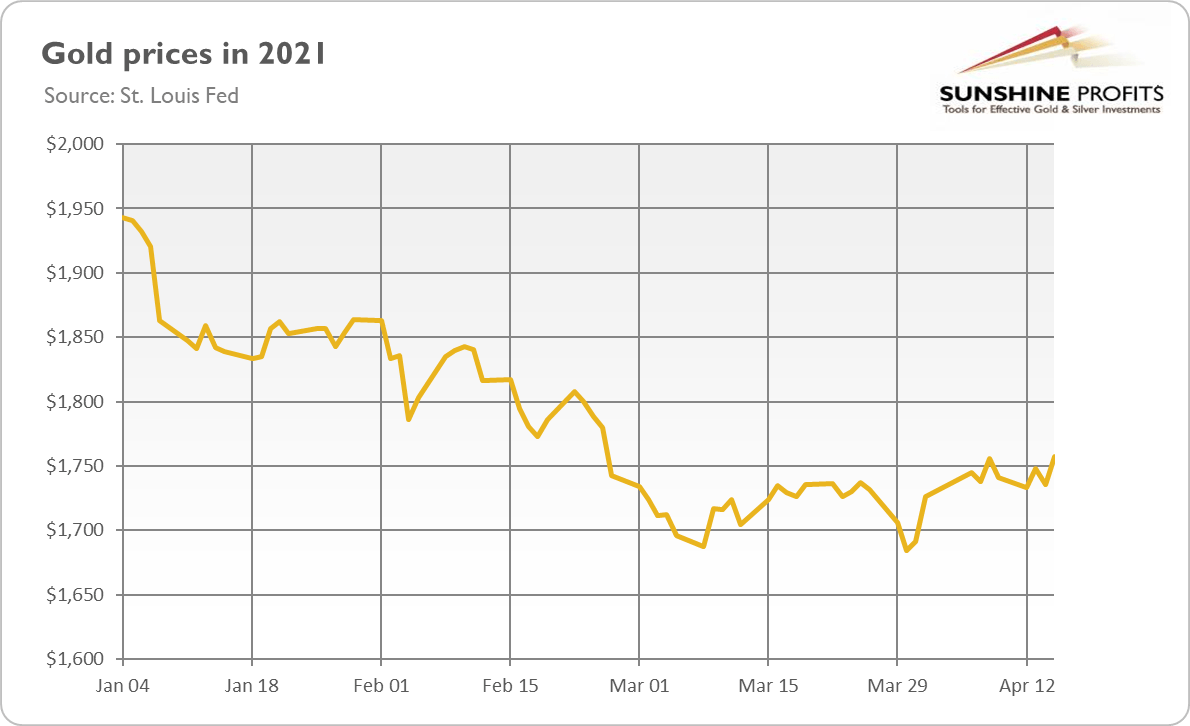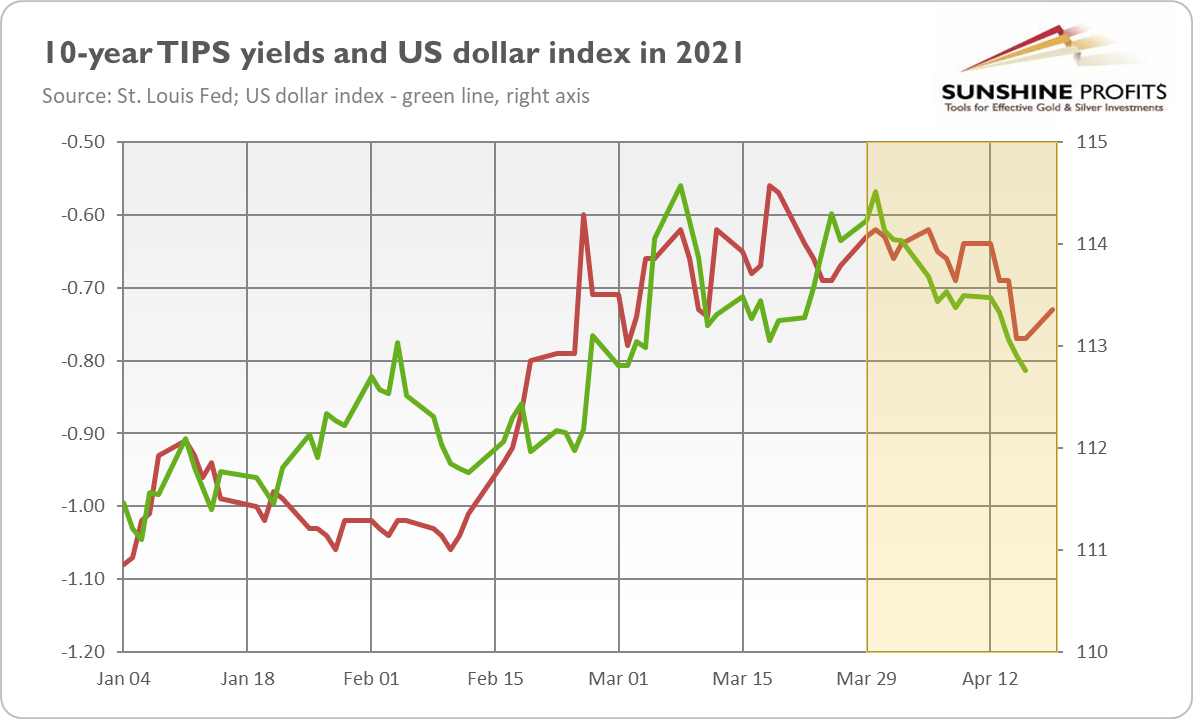The price of gold rebounded further, despite hawkish Powell’s letter to Senator Rick Scott.
The second quarter of 2021 started much better than the first one for the gold bulls. As the chart below shows, the yellow metal rebounded from the late March bottom of $1,684 to $1,778 on Tuesday (April 20).
Is it a temporary recovery in a long, downward slide or a return to the bull market that started in 2019? Well, it’s probably too early to determine whether that’s the case. What is, however, crucial here is that the yellow metal has managed to go up, despite some bearish news. The most important fact is that Powell has replied to the letter from Senator Rick Scott on rising inflation and public debt . The Fed Chair’s reply was rather hawkish , as he said that any overshoot of inflation target would be limited:
We do not seek inflation that substantially exceeds 2 percent, nor do we seek inflation above 2 percent for a prolonged period (…) we are fully committed to both legs of our dual mandate – maximum employment and stable prices (…) We understand well the lessons of the high inflation experience in the 1960s and 1970s, and the burdens that experience created for all Americans. We do not anticipate inflation pressures of that type, but we have the tools to address such pressures if they do arise.
Although Powell didn’t say anything surprising, his tone and emphasis on the commitment to stable prices could be interpreted as generally hawkish and, thus, negative for the gold prices. However, the yellow metal continued its rebound, which is encouraging.
Implications for Gold
So why has gold been rising recently? Well, in a sense, the reason might be simple: the sentiment was so negative that the downward trend had to reverse. However, there are also some fundamental factors at play here. First of all, the rallies both in the bond yields and the US dollar have stalled . As the chart below shows, both the greenback and the real interest rates have receded from their March peaks..
The declines in the bond and forex markets enabled gold to catch its breath. Of further importance is that they started falling when it became clear that the Fed would be more dovish and tolerant of higher inflation than was originally believed by the markets.
Second, there has been a surge in global coronavirus cases which renewed a demand for the safe-haven assets, such as gold . Also, in the US, the number of confirmed cases and hospitalizations is increasing in some areas of the country, despite the vaccination progress. That is the effect of the new variants of the virus and the pandemic fatigue, i.e., many people tired of it have dropped their infection control measures.
Third, inflation is accelerating , which is becoming increasingly visible. For example, the latest IHS Markit U.S. Manufacturing PMI shows that costs and charges have historically elevated in March.
Supplier lead times lengthened to the greatest extent on record. At the same time, inflationary pressures intensified, with cost burdens rising at the quickest rate for a decade. Firms partially passed on higher input costs to clients through the sharpest increase in charges in the survey’s history.
Commenting on the numbers, Chris Williamson, Chief Business Economist at IHS Markit, said:
Raw material prices are increasing at the sharpest rate for a decade and factory gate selling prices have risen to a degree not seen since at least 2007. The fastest rates of increase for both new orders and prices was [sic] reported among producers of consumer goods, as the arrival of stimulus cheques in the post added fuel to a marked upswing in demand.
What matters here is that the inflationary pressure is likely to remain with us for a while, despite the pundits’ claims that it’s triggered merely by temporary factors. In the 1970s, they were talking the same – until stagflation emerged and gold shined.
Want free follow-ups to the above article and details not available to 99%+ investors? Sign up to our free newsletter today!
All essays, research and information found above represent analyses and opinions of Przemyslaw Radomski, CFA and Sunshine Profits' employees and associates only. As such, it may prove wrong and be a subject to change without notice. Opinions and analyses were based on data available to authors of respective essays at the time of writing. Although the information provided above is based on careful research and sources that are believed to be accurate, Przemyslaw Radomski, CFA and his associates do not guarantee the accuracy or thoroughness of the data or information reported. The opinions published above are neither an offer nor a recommendation to purchase or sell any securities. Mr. Radomski is not a Registered Securities Advisor. By reading Przemyslaw Radomski's, CFA reports you fully agree that he will not be held responsible or liable for any decisions you make regarding any information provided in these reports. Investing, trading and speculation in any financial markets may involve high risk of loss. Przemyslaw Radomski, CFA, Sunshine Profits' employees and affiliates as well as members of their families may have a short or long position in any securities, including those mentioned in any of the reports or essays, and may make additional purchases and/or sales of those securities without notice.
Recommended Content
Editors’ Picks

EUR/USD stays near 1.0400 in thin holiday trading
EUR/USD trades with mild losses near 1.0400 on Tuesday. The expectation that the US Federal Reserve will deliver fewer rate cuts in 2025 provides some support for the US Dollar. Trading volumes are likely to remain low heading into the Christmas break.

GBP/USD struggles to find direction, holds steady near 1.2550
GBP/USD consolidates in a range at around 1.2550 on Tuesday after closing in negative territory on Monday. The US Dollar preserves its strength and makes it difficult for the pair to gain traction as trading conditions thin out on Christmas Eve.

Gold holds above $2,600, bulls non-committed on hawkish Fed outlook
Gold trades in a narrow channel above $2,600 on Tuesday, albeit lacking strong follow-through buying. Geopolitical tensions and trade war fears lend support to the safe-haven XAU/USD, while the Fed’s hawkish shift acts as a tailwind for the USD and caps the precious metal.

IRS says crypto staking should be taxed in response to lawsuit
In a filing on Monday, the US International Revenue Service stated that the rewards gotten from staking cryptocurrencies should be taxed, responding to a lawsuit from couple Joshua and Jessica Jarrett.

2025 outlook: What is next for developed economies and currencies?
As the door closes in 2024, and while the year feels like it has passed in the blink of an eye, a lot has happened. If I had to summarise it all in four words, it would be: ‘a year of surprises’.

Best Forex Brokers with Low Spreads
VERIFIED Low spreads are crucial for reducing trading costs. Explore top Forex brokers offering competitive spreads and high leverage. Compare options for EUR/USD, GBP/USD, USD/JPY, and Gold.

